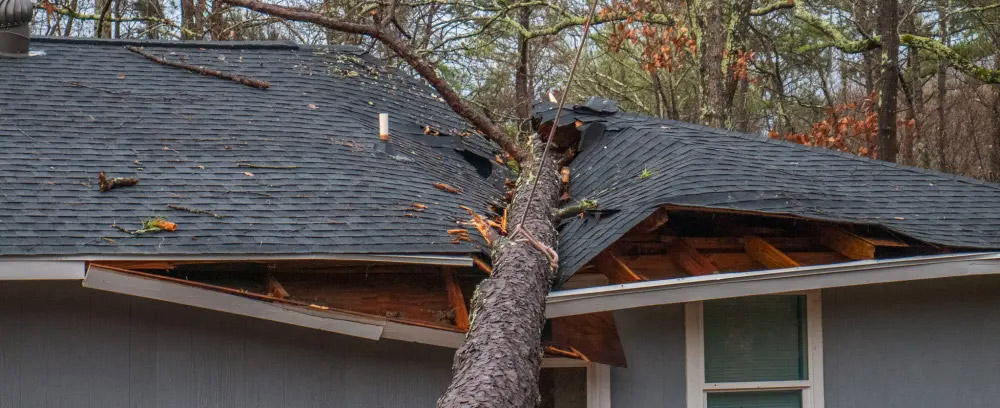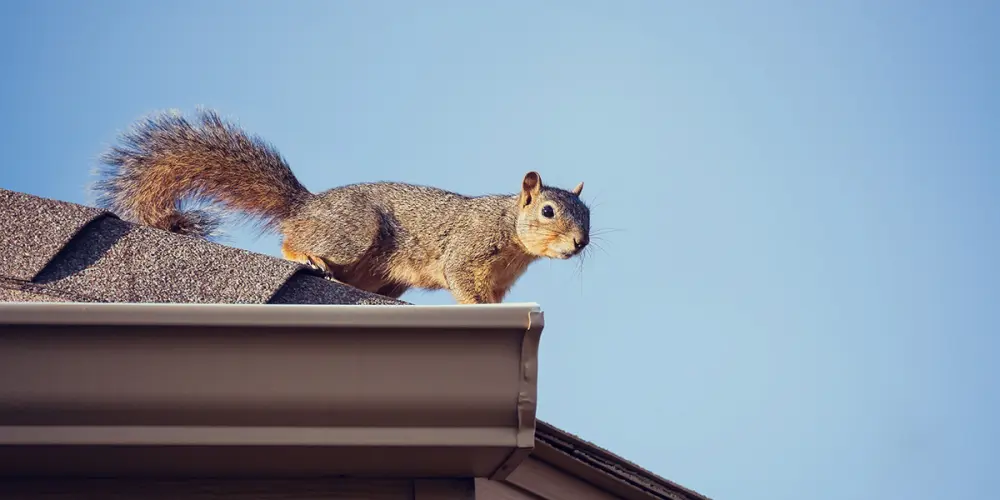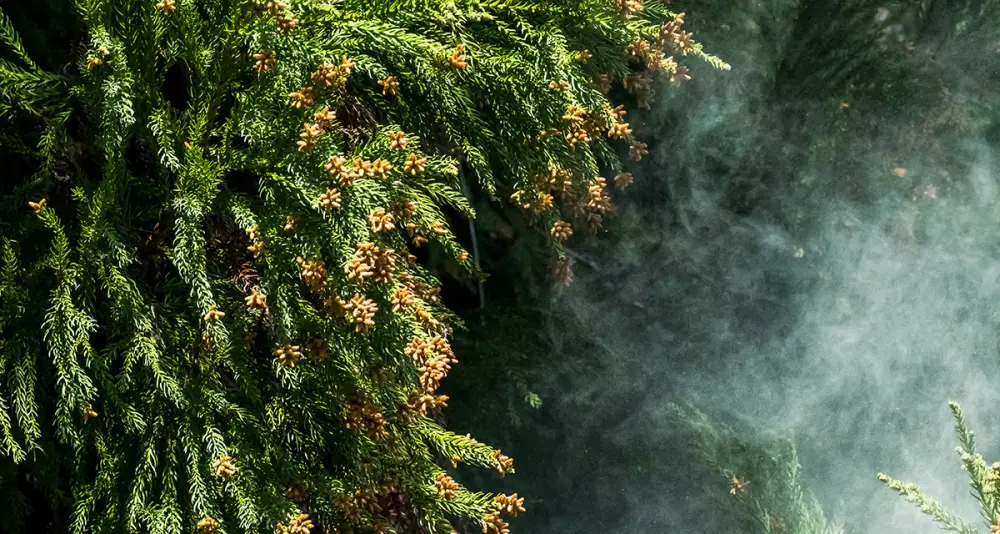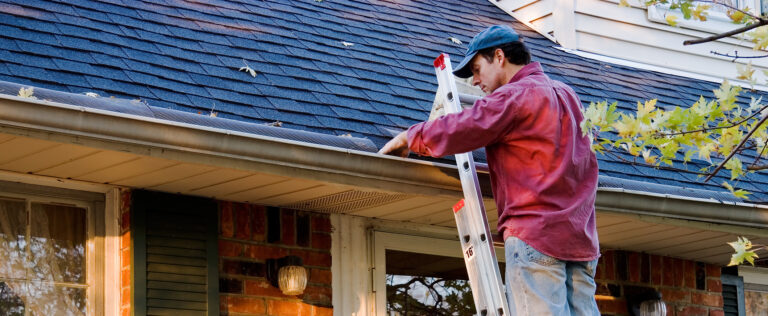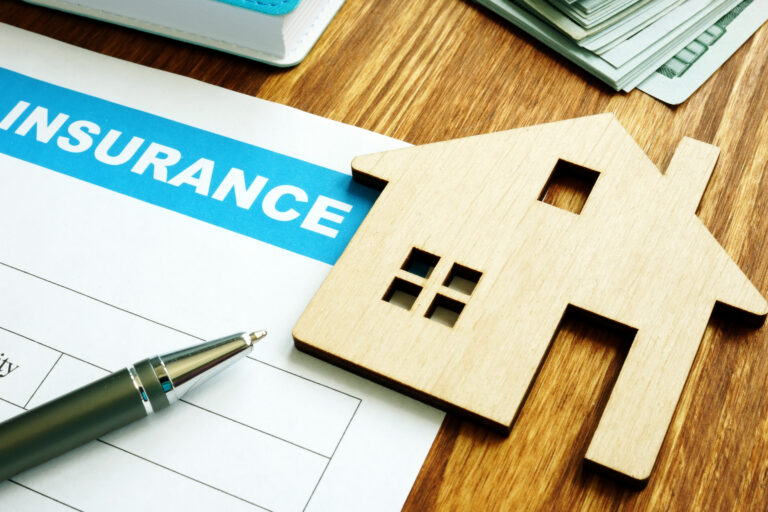The Ways Trees Can Damage Residential Roofs and How to Prevent Tree Damage
Table of Contents:
- The Ways Trees Benefit Roofs
- How Trees Can Damage Roofs
- How Far Should Tree Branches be From Your Roof?
- What You Can Do to Prevent Roof Damage From Trees
- My Neighbor’s Tree Branches are Touching my Roof
- Signs That a Tree is Ill or Unstable
- How to Prevent Damage From Trees Before a Storm
- What to Do if a Tree has Fallen on Your Home
- Are There Some Roof Types That are More Resistant to Tree Damage Than Others?
Disclaimer: Always refer to an arborist (i.e., a tree expert) before making a decision about your tree. Never trim a tree that overhangs your roof yourself. Instead, always employ an expert, or you may damage your roof. Please also note that there may be laws in your jurisdiction governing the removal of trees that are part of a protected species.
Home buyers often seek out homes with mature trees because they’re beautiful. These trees offer shade, greenery and perhaps even fragrant flowers. However, mature trees aren’t all good news. There are many ways that trees can reduce the life of your roof and its shingles unless you step in to prevent it.
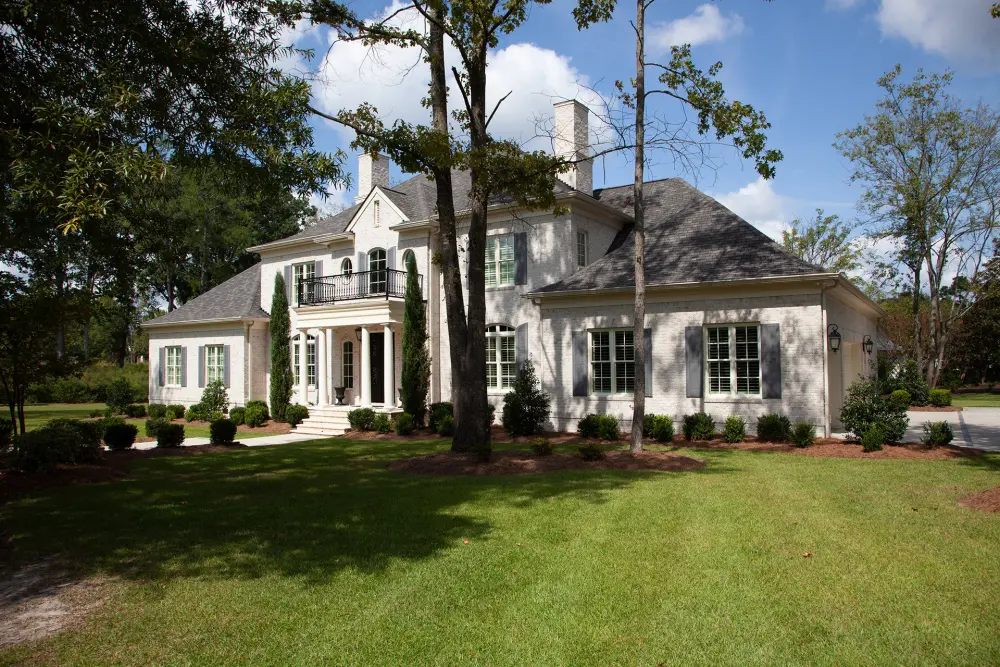
Thankfully, proper tree management is simple and cheap, and can prevent almost all roof damage from trees. In this article, we’ll discuss the ways that trees can damage shingles and how you can prevent each type of damage. We’ll also discuss what you should do if your tree (or your neighbor’s tree) has already damaged your roof or fallen on your roof.
The Ways Trees Benefit Roofs
Don’t get out the chainsaw just yet. There are many reasons to keep your trees around. Trees offer your home shade and enhance its beauty. They can even offer shingles protection, under the right circumstances. Trees benefit roofs by:
- Blocking the wind: Mature trees that are upwind of the roof can block a great deal of wind, reducing its effect on your shingles, especially during severe windstorms.
- Providing ultraviolet (UV) ray protection: Mature trees may also shade your roof. Shorter trees may only shade your roof in the early hours of the morning or late in the evening. Still, any shade can help reduce the effect of UV light on your asphalt shingles. Over time, UV light shortens the life span of most roofing materials.
- Moderating summer temperature: In summer, the shade the tree provides will also help reduce the temperature in your home. Roofing shingles absorb heat from the sun and can radiate that heat back into your home at night.
How Trees Can Damage Roofs
- Falling on roofs: There’s always the possibility that your tree could fall on your roof if it is damaged, ill or too weak to withstand a windstorm. We’ll discuss the signs a tree is unstable below.
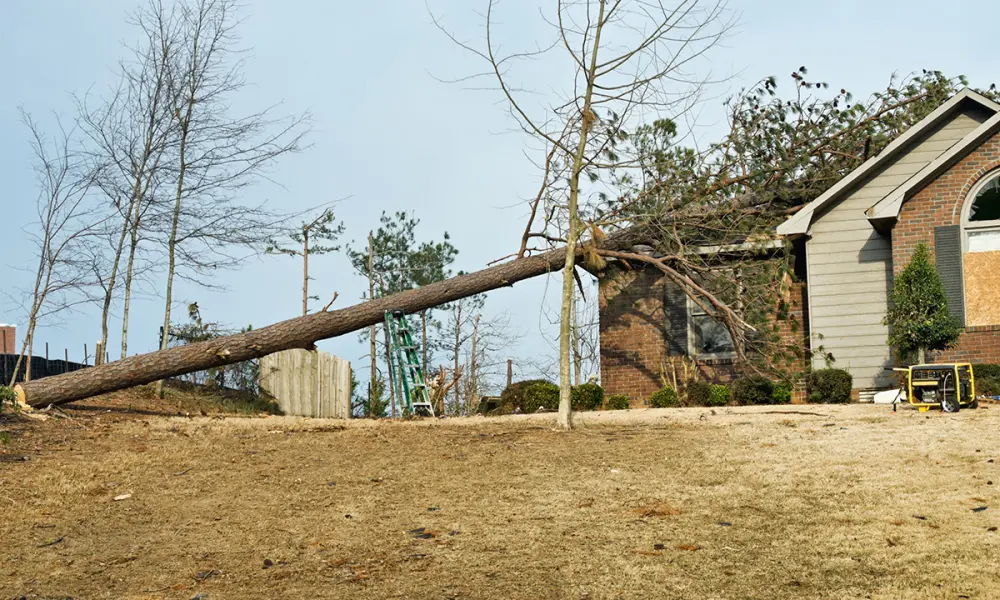
- Dropping branches: Can tree branches damage a roof? Yes, even small branches can scratch roofs just as they would scratch a window. If they are blown off the tree by a storm, they may find their way to damage your shingles. Several large branches may add too much weight to your roof or even cause dents on impact just as a fallen tree could. This damage is more likely in the winter when the tree branches are heavy with snow and ice.
- Low-hanging branches: If not pruned, tree branches may hang over your roof. If these branches touch the roof or rub up against the roof during a windstorm, they can scratch away at the shingle’s outer protective layer. Tree branches that overhang a roof such that they can touch or abrade the shingles when the wind blows should be properly trimmed.
- Dropping leaves and needles: Deciduous trees drop their leaves every fall and make a big mess on your rooftop. Plus, evergreen trees may drop their needles all year round. Is this debris from your tree bad for your roof? Yes, if you let it collect. Leaves and needles can clog your gutters and valleys, which can spell trouble for your roof. By absorbing moisture, this debris can also encourage mold, moss or algae growth, which can discolor your roof or reduce its life span. If this is a frequent problem in your area, you can choose shingles with algae-resistant granules, such as IKO’s Dynasty®, Cambridge™ or Marathon™ Plus AR shingles. You may also want to consider gutter guards to prevent debris buildup in rain gutters.
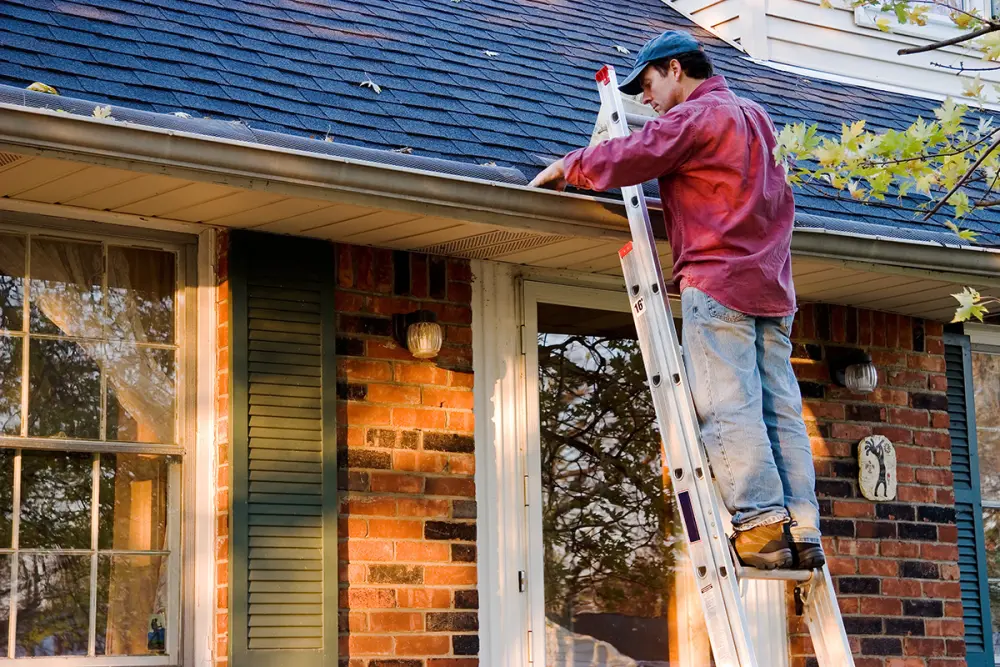
- Dropping nuts and fruits: While most trees drop debris, such as leaves, that falls gently onto roofs, others have more serious ammunition. For example, walnut trees drop large, heavy nuts that may do damage to a roof, especially after a few years. Homeowners should avoid planting these trees near roofs. For the same reason, it is wise to avoid all fruit trees as well as hickory, pecan, chestnut, Osage orange and sweet gum trees.
- Excessive shade: A little shade is a benefit in the summer to help keep your home cool. On the other hand, too much shade can make it difficult for your roof to dry off. If it stays wet for too long, your roof may develop mold and algae growth. IKO has many algae-resistant shingles that can help combat this problem, including Dynasty®, Cambridge™ or Marathon™ Plus AR
- Animal access: Mature trees can allow animals, especially squirrels, to venture onto your roof. They may simply sit on your roof for a while, or they may choose to nest on your roof if they see the opportunity. It’s wise to cut back tree branches so that animals won’t try to jump onto your roof.
How Far Should Tree Branches be From Your Roof?
In general, the tips of a tree’s branches should be at least six feet from the roof. Therefore, some large trees must be planted 20 to 30 feet away from the home to keep their branches a safe distance.
It is also wise to check with your homeowner’s insurance policy to discover if they have requirements about tree distance. Typically, homeowner’s insurance covers home and roof damage from trees. However, an insurance company may refuse to cover damages if they find you were negligent by allowing a tree to grow too close to your home, allowing branches to hang over your roof or allowing the tree to become diseased without taking appropriate steps to treat or remove it.
What You Can Do to Prevent Roof Damage From Trees
- Trim the tree: Trim all tree branches that are too close to the roof. It is best to ask an arborist to remove overhanging branches, as they will be able to protect your roof as they work. Or you can use the same strategies you’d use to protect your home and garden during a roof installation. Also, if you find that you need to prune more than 25 percent of the tree, it may be better to remove the tree entirely. A tree that has experienced such an extreme pruning is likely to die and fall over.
- Prune young trees: You can use pruning to control tree growth. You may prune young trees so that they only develop strong crotches (the junction between the branch and trunk), which are less likely to break off in storms.
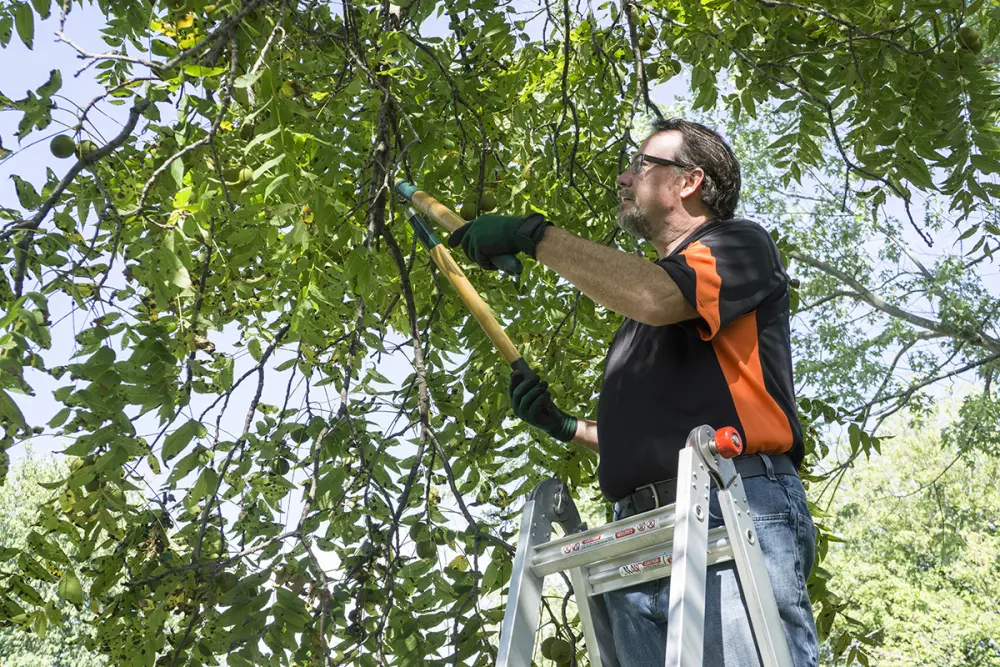
- Clean up debris: Remove tree debris from the roof and the gutters as soon after it has fallen as you can. If you have a tree that drops debris all year, such as a pine tree, you will need to clean the gutters and roof every few months.
- Cut down unstable trees: Trees that are unstable or seriously ill should be cut down quickly before they have the chance to fall onto your roof. However, first check with your local city bylaws and your arborist. Some tree species are protected and cannot be cut down. Other areas prohibit removing trees with a certain trunk diameter.
My Neighbor’s Tree Branches are Touching my Roof
What if you don’t own the tree that is unstable or too close to your home? Politely asking your neighbor if you can trim back the tree is the wisest course of action, instead of asking them to trim it.
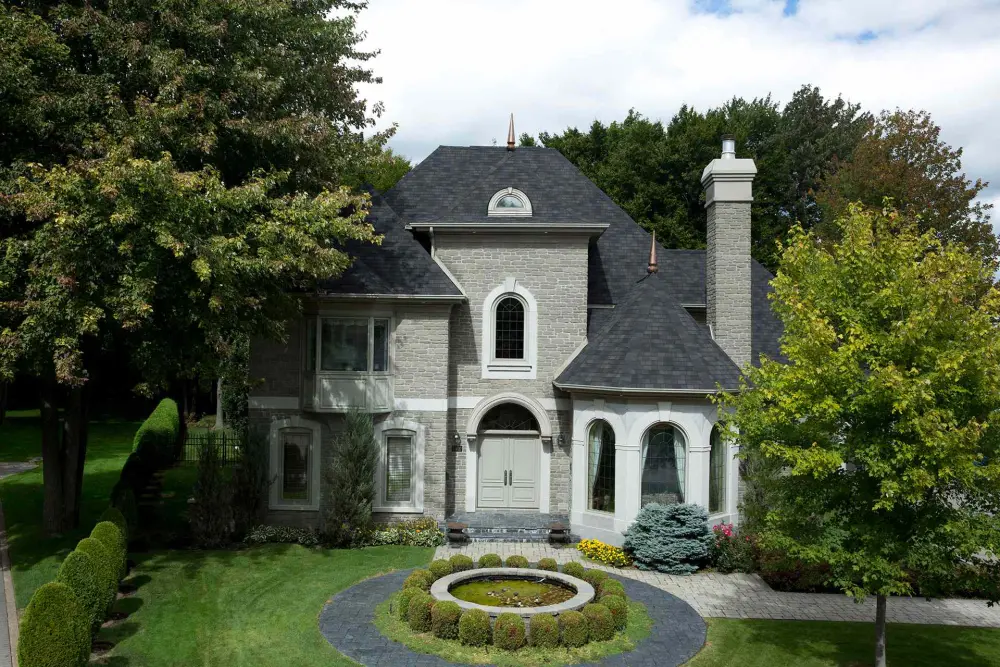
Your neighbor may not be as thorough as you would like them to be.
If your neighbor refuses to allow you to trim the tree, some cities have bylaws or ordinances that can force your neighbor to allow it. As these laws vary by location, you should seek legal advice about this issue. Remember that the tree is your neighbor’s property, and you may be liable if you trim it without a legal right to do so.
What if your neighbor’s tree has already fallen on your home? Your insurance company may cover damage to your roof from your neighbor’s tree, depending on your specific insurance policy and local laws. Be sure to tell the insurance agent that you don’t own the tree that caused the damage. They may try to hold your neighbor accountable for neglecting the tree and could recover your deductible through these efforts.
If your insurance policy doesn’t cover tree damage, you will likely end up paying for the damage out of pocket. Whether or not you can hold your neighbor responsible for damage caused by their tree depends on many factors. It is best to get advice from your insurance broker or an attorney on this matter.
Signs That a Tree is Ill or Unstable
You should always refer to an arborist to make the final decision about a tree’s health. However, there are a few signs you can be on the lookout for that indicate your tree may be unstable or dead and at risk of falling on your roof, including:
- Splitting trunk: Experts can sometimes save trees with large cracks in their trunks. Refer to an arborist and do not tie the tree with rope yourself. An arborist may brace a tree with rope and bolts, but only they can determine if a tree will be safe in this state. A splitting tree can easily rip through rope and fall onto your home. A serious split, such as the one below, is an emergency.
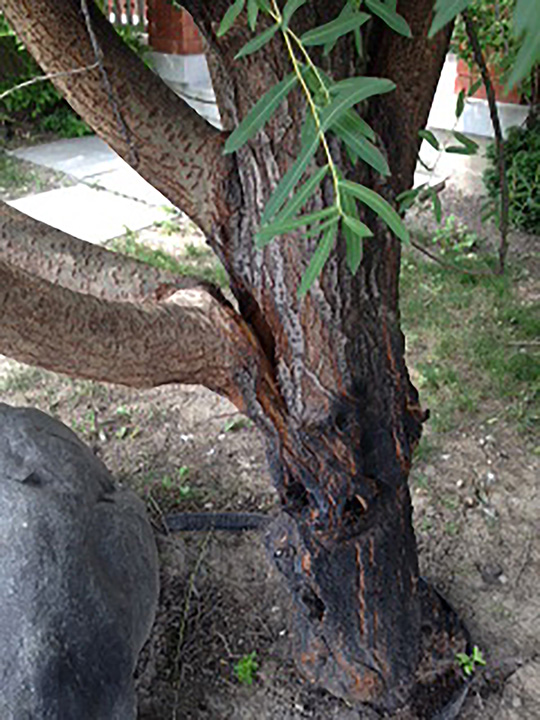
- Fungus: Trees have immune systems just like we do. Their system is designed to fight off fungi, among other things. If your tree has a fungus growing on it, it could be a sign its immune system isn’t working. Most branches with fungus will die and fall off the tree. Plus, the infection can spread and kill the whole tree. However, there are many different kinds of fungus that can infect trees, and some are signs of infection. When you’re looking for fungi on your tree, keep in mind that it can be many colors, shapes and sizes. Most commonly, you’ll find fungus growing like shelves on the tree branches or collected on the base of the tree.
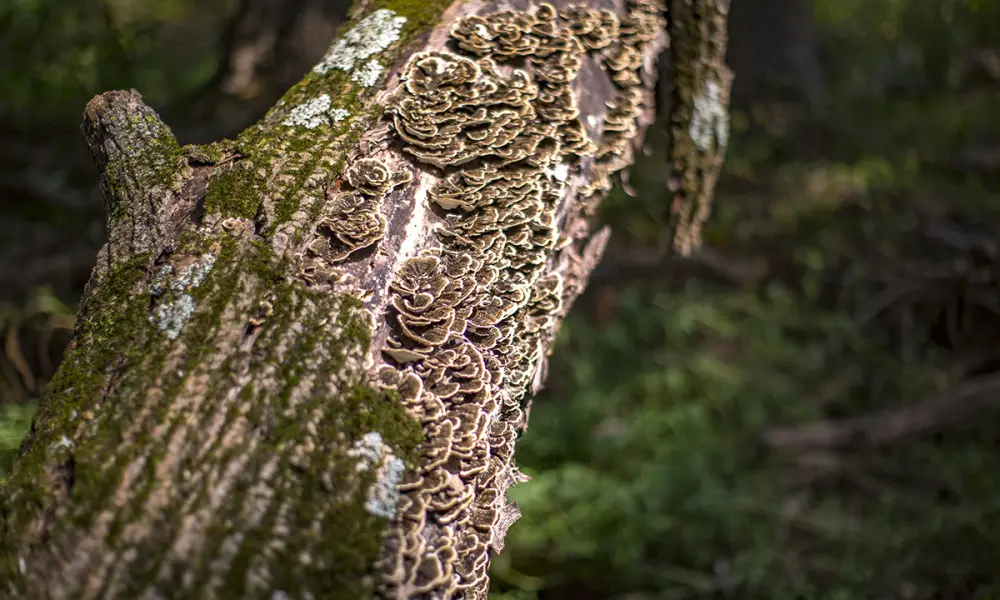
- Rotting branches: May be black or have holes. Rot can spread, so rotting branches should be cut off trees immediately.
- Leaning: A tree that leans to one side may be at risk of falling over. Its canopy may be unbalanced, with more weight on one side of the branches, or the roots on one side of the tree may be pushed upwards by soil conditions.
- Missing leaves: When your tree is in season, look for any branches that are missing leaves. These have an illness or have been cut off from nutrients.
- Peeling bark: A tree that is missing bark may be infected. Trees have tough material beneath their bark, but it doesn’t protect them. Instead, this material acts as their veins and arteries, carrying nutrients up to the leaves. Without bark, fungi and other infections can travel throughout the tree. Keep in mind that some trees, including birch, shed their bark naturally. If the shedding is normal, there will be new bark beneath the old.
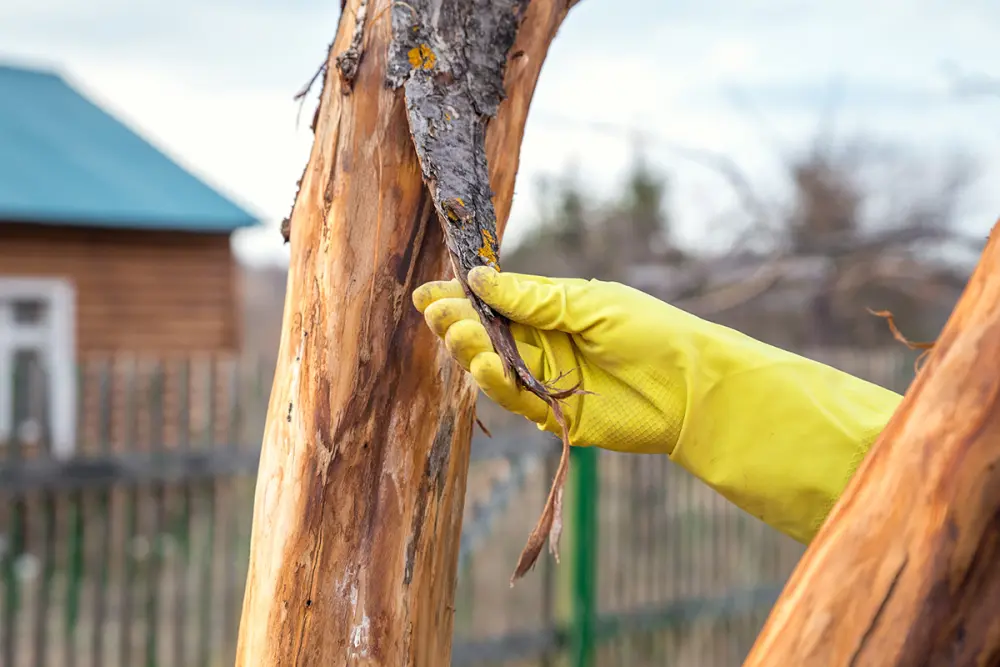
- Swollen spots: Unusual growths on a tree can be the result of infections, or they may be a natural part of the tree. You’ll need to refer to an expert to be sure.
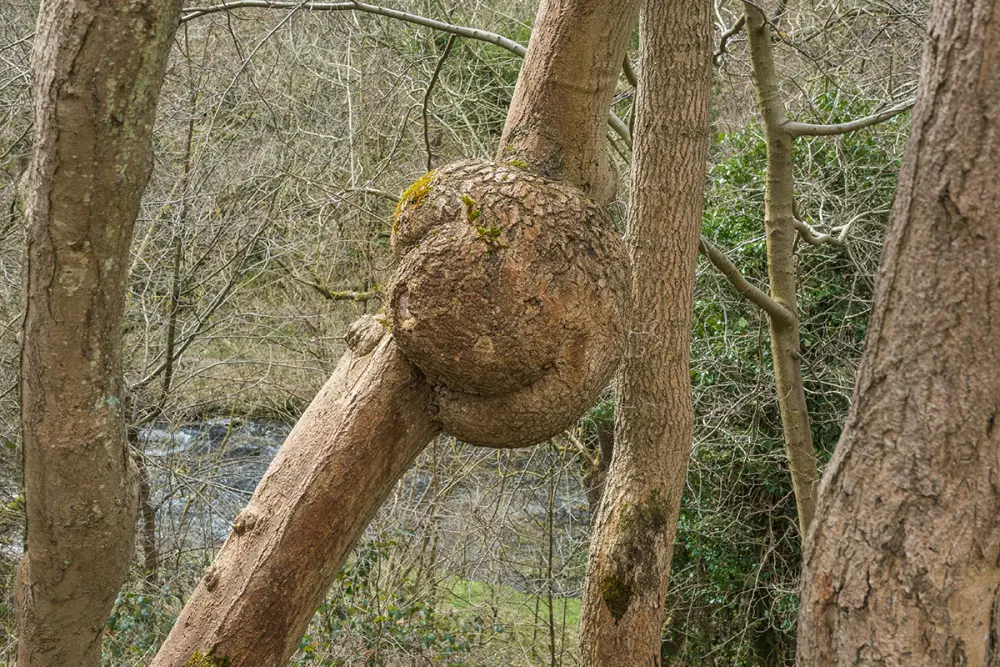
- Discolored leaves: Many tree illnesses infect the leaves. These infections may turn leaves any color or may cause small growths. Not all of these infections are deadly to trees, so talk to your arborist to find out if your tree can be saved and how.
How to Prevent Damage From Trees Before a Storm
If a wind or rain storm is in the forecast, there are a few things you should do before the storm hits to prevent roof damage:
- Check tree health: If a tree has fallen ill, now is your last chance to address it before the storm. Look for all the signs of an unhealthy tree that we listed above.
- Trim the tree: If there are any dead branches, or if the branches have grown too close to the roof, trim them back. Otherwise, the storm may pull them loose for you.
- Clean gutters and downspouts: Debris in your gutters or on your roof during a storm is likely to cause a clog or prevent your roof from draining properly.
- Clean rooftop: While you’re cleaning the gutters, gently brush off any leaves or pine needles on the shingles. This will allow stormwater to move off the roof unobstructed.
What to Do if a Tree has Fallen on Your Home
- Evacuate: If a tree has fallen on your home and has pierced through the siding or the roof, or if it has put tremendous weight on the roof, it is best to evacuate your family from the home. Few trees are capable of collapsing a well-maintained home, but falling debris can be a safety hazard. Until an expert has assessed the damage, it’s better to be safe than sorry. If someone is stuck or cannot be evacuated, call 911.
- Call your insurance company: Your insurance company may want to send someone out to investigate. Plus, they will tell you how to make your claim. Double-check the amount of your deductible and be prepared to pay it. Also, remember to find and document all of the damage, including to the home’s roofing, siding, plumbing, furniture, windows, doors, HVAC equipment and front lawn. It is wise to wait to greenlight any repairs until your insurance company confirms your claim, as they may set a limit on repair costs.
- Assess damage: While you wait for the professionals to arrive, survey the damage. Take pictures of anything that has been damaged. The tree may have pulled down an electric line or caused damage to the plumbing or gas lines in the home. So, if you see water leaks or sparks, or if you smell a gas leak, do not investigate further. Instead, call both 911 and your utility company to ask them to shut off service to your home until the damage can be fixed by a professional.
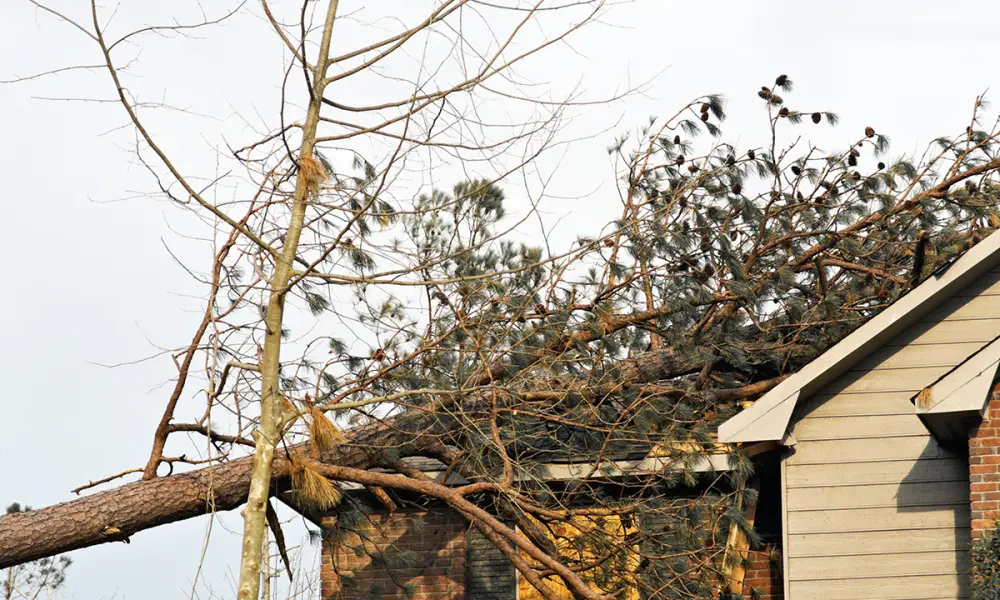
- Call a roofer and arborist: Your insurer may have you call in the professionals. You may need the arborist to remove the tree safely and the roofer to fix any damage the tree has caused. However, you should not agree to their services or pay for anything without talking to your insurer first. Otherwise, your insurance provider may not cover the cost. If your policy carrier has agreed to services, be sure to keep their receipts.
- Get the damaged fixed: Once your insurance company is sorted out, follow your adjuster’s advice. You may need to hire professionals to repair your roof and any other damage you incurred. Your arborist may recommend removing the rest of the tree in order to prevent more damage, however most policies have a limit on tree removal and it is usually not enough to remove the entire tree.
Are There Some Roof Types That are More Resistant to Tree Damage Than Others?
Your intuition may tell you that a metal roof will resist tree damage better than other kinds of roofing; but that’s not the case. Metal roofs have waterproof finishes that may scratch as easily as a shingle can from a fallen branch. Metal roofs may also dent under the pressure of a tree.
In the end, all roofing materials can be damaged by a tree. The best course of action is to practice proper tree management to prevent roof damage. Take your arborist’s advice about which trees on your property are safe and which need to be removed or trimmed back. When you choose a new tree, ensure it is planted far enough away from your roof. Regularly clean your roof and gutters to maintain proper water flow on your roof. If you take these precautions, especially before storms, you can avoid roof damage from trees.
If you need a roofing professional to clean tree debris from your roof or repair damage a tree has caused to your roof, you can find one through our Contractor Locator.
